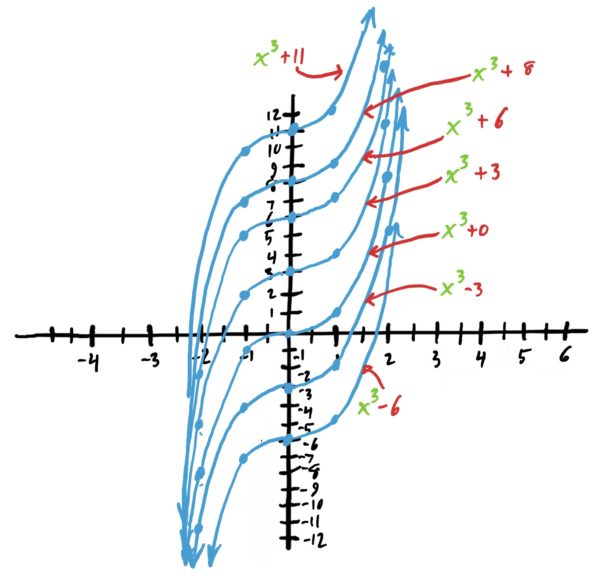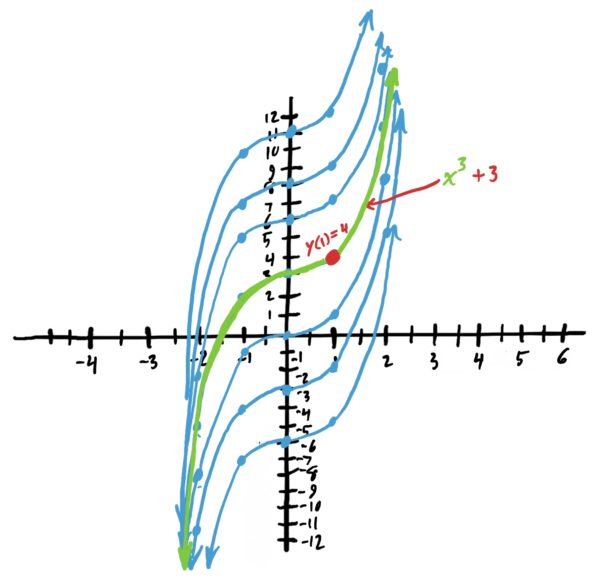Initial Value Problems: Solving for C
Recall where the “+C” came from
Let \(y(x)\) be a function and suppose we are given it’s derivative \(y'(x)=3x^2\). If our goal is to use this information to find the original function \(y\) from it’s derivative, we note that the power rule for antiderivatives gives us an antiderivative \(x^3\). While it is certainly true that \(\frac{d}{dx} x^3 = y'(x)\) (i.e. \(x^3\) ‘s derivative matches the one we were given) it is NOT the only function with this derivative! Notice that the functions \(x^3+1\), \(x^3+5000\), \(x^3-5.124\) and \(x^3+412384182\) all have the same derivative of \(3x^2\), making each of these (and infinitely many others) a perfectly valid answer for what \(y(x)\) could be.
Notice also that the difference between all these candidate answers for \(y(x)\) is the constant we are adding or subtracting to/from the \(x^3\). All of these different constants would vanish when you derive any of these candidates, giving you \(y'(x)=3x^2\).
Thus, if we simply started with the derivative \(y'(x)=3x^2\) and we want to find the original function \(y(x)\) whose derivative is \(y'(x)=3x^2\), we would write \(y(x)=x^3+C\) where the \(+C\) represents the constant that would get derived away when going from \(y\) to \(y’\). Because that constant got “derived away,” there is not enough information to determine what that constant was originally.
Sometimes, we are given enough information that would help us determine what C is.
Finding the Constant C
Suppose, again, that we are given a function’s derivative \(y'(x)=3x^2\) and we are again tasked with determining the antiderivative \(y(x)\) of \(y'(x)\) given also a little extra information: \(y(1)=4\) (i.e. we know a single point that the graph of \(y\) passes through).
In the last section we said that there are many possible antiderivatives for \(y'(x)=3x^2\), all of which differ by a constant \(C\). Specifically, we said that the original function \(y\) must have the form \(y(x)=x^3+C\) where \(C\) is an unknown constant.
Recall from a precalculus or algebra course that when you add or subtract a constant \(C\) to/from a function this has the effect of shifting the function’s graph up or down by \(C\). Because of this, our solution for \(y(x)\) can be any of the following graphed functions (which are all shifted up or down based on what \(C\) is).

So, if we know that \(y(1)=4\), which of these graphs is the function we want for \(y(x)\)? Since \(y(x)=x^3+C\) for some \(C\), and \(y(1)=4\) we know that \((1)^3+C=4\) (when we plug in \(x=1\) and set it equal to \(y=4\)). Solving for \(C\) gives us \(C=3\). Therefore, our antiderivative of \(y'(x)=3x^2\) given that \(y(1)=4\) is \(y(x)=x^3+3\). The correct antiderivative graph is highlighted below. Note that the condition of \(y(1)=4\) essentially told us which one we wanted (and therefore what \(C\) is).

We start by finding the indefinite integral \(\int 2x+1\ dx\). This is
$$y(x)=\int 2x+1\ dx = x^2+x+C$$
for some unknown \(C\) that we will solve for next.
We are given that \(y(0)=5\). So this implies
$$(0)^2+(0)+C=5$$
But this immediately gives us that \(C=5\). Therefore the antiderivative of \(\frac{dy}{dx}=2x+1\) where \(y(0)=5\) is
$$y(x)=x^2+x+5$$
Solving up from second (or more) derivatives
Suppose you are given a function’s second derivative \(y”(x)=5x\) and an initial condition for the derivative \(y'(x)\) and the original function \(y(x)\), specifically \(y'(0)=1\) and \(y(0)=3\). To go from teh second derivative given all the way up to the original function, simply rinse-and-repeat the steps above! You’ll end up antideriving twice and solving for an unknown constant twice. This is illustrated in the mini example below.
Start by finding the antiderivative of \(y”(x)=5x\). This will give us a general form for the first derivative \(y'(x)\).
$$y'(x)=\int 5x\ dx=\frac{5x^2}{2}+C$$
Before antideriving again to get \(y(x)\) we need to first find \(C\). Plug in the initial value information \(y'(0)=1\). This gives us that
$$\frac{5(0)^2}{2}+C=1$$
which implies (after simplifying) that \(C=1\). Therefore, \(y'(x)=\frac{5x^2}{2}+1\).
Now we want to find \(y(x)\), so we repeat the process above.
$$\int \frac{5x^2}{2}+1\ dx=\frac{5x^3}{6}+x+C$$
Since we know that \(y(0)=3\), the above implies
$$\frac{5(0)^3}{6}+(0)+C=3$$
Which implies \(C=3\). Therefore, we have the final answer for \(y(x)\):
$$y(x)=\frac{5x^3}{6}+x+3$$
First find the antiderivative of the function given, then plug in the given x-value 0, and set the result equal to 1. Solve for C.
Power Rule for Antiderivatives: \(\int x^n\ dx=\frac{x^{n+1}}{n+1}+C\)
First find the antiderivative of the function given, then plug in the given x-value, and set the result equal to the given y-value. Solve for C.
\(y(x)=\frac{3x^2}{2}+x+1\)
First find the antiderivative of the function given, then plug in the given x-value 0, and set the result equal to 1. Solve for C.
Power Rule for Antiderivatives: \(\int x^n\ dx=\frac{x^{n+1}}{n+1}+C\)
First find the antiderivative of the function given, then plug in the given x-value, and set the result equal to the given y-value. Solve for C.
\(y(x)=\frac{x^3}{3}-3x+\frac{17}{3}\)
First find the antiderivative of the function given, then plug in the given x-value 0, and set the result equal to 1. Solve for C.
Power Rule for Antiderivatives: \(\int x^n\ dx=\frac{x^{n+1}}{n+1}+C\)
First find the antiderivative of the function given, then plug in the given x-value, and set the result equal to the given y-value. Solve for C.
\(y(x)=\frac{x^3}{3}+x^2+x+\frac{13}{3}\)
First find the antiderivative of the function given, then plug in the given x-value -1, and set the result equal to -5. Solve for C.
First find the antiderivative of the function given, then plug in the given x-value, and set the result equal to the given y-value. Solve for C.
Power Rule for Antiderivatives: \(\int x^n\ dx=\frac{x^{n+1}}{n+1}+C\)
\(y(x)=9x^{\frac{1}{3}}+4\)
First find the antiderivative of the function given, then plug in the given x-value, and set the result equal to the given y-value. Solve for C.
Power Rule for Antiderivatives: \(\int x^n\ dx=\frac{x^{n+1}}{n+1}+C\)
First find the antiderivative of the function given, then plug in the given x-value, and set the result equal to the given y-value. Solve for C.
\(y(x)=\frac{5x^3}{6}-x^2+x+2\)
First find the antiderivative of the function given, then plug in the given x-value, and set the result equal to the given y-value. Solve for C.
Power Rule for Antiderivatives: \(\int x^n\ dx=\frac{x^{n+1}}{n+1}+C\)
First find the antiderivative of the function given, then plug in the given x-value, and set the result equal to the given y-value. Solve for C.
\(y(x)=\frac{x^4}{12}-\frac{x^3}{3}+\frac{8}{3}x+1\)
First find the antiderivative of the function given, then plug in the given x-value, and set the result equal to the given y-value. Solve for C.
Power Rule for Antiderivatives: \(\int x^n\ dx=\frac{x^{n+1}}{n+1}+C\)
First find the antiderivative of the function given, then plug in the given x-value, and set the result equal to the given y-value. Solve for C.
\(y(x)=\frac{x^{-1}}2{2}+\frac{3}{2}x-1\)
